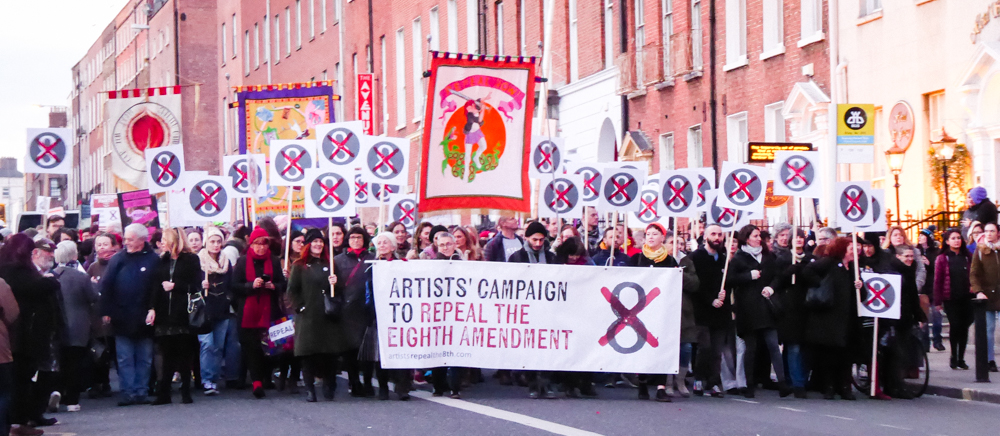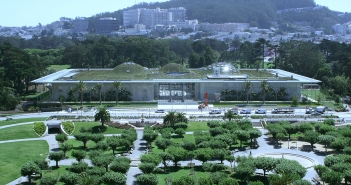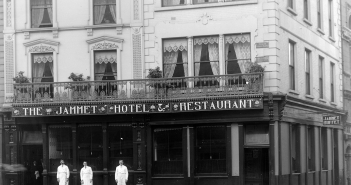‘I have never met a man so in love with the written word – provided he himself has written it’
Vincent Mercier on his editor at The Bell Sean O’Faoláin.
In this second and final instalment, Frank Armstrong reviews Periodicals and Journalism in Twentieth-Century Ireland 2: A Variety of Voices edited by Mark O’Brien and Felix M. Larkin and published by the Four Court Press in Dublin this year.
It follows his review of Periodicals and Journalism in Twentieth Century Ireland: Writing Against the Grain (2014) edited by the same authors.
This book delves deeper into the canon of dissenting Irish journalism and weighs up the consequences of the arrival of the internet for critical journalism in this country.
In the first of two reviews, Frank Armstrong revisits ‘the fulcrum on which the intellectual foundations of Irish society moved – slowly, but irrevocably.’https://t.co/KoU3AnPLUx@broadsheet_ie @BowesChay @paddycosgrave @FourCourtsPress @fallon_donal @corourke91 @AlanGilsenan1
— CassandraVoices (@VoicesCassandra) June 7, 2022
Digital Flood
John Horgan observes in Great Irish Reportage (Random House, Penguin, London, 2013) that ‘Writing about current events will have been transformed by the rise of digital media in ways we can only guess at.’ This may seem an obvious statement, but we can surely hazard a guess as to some consequences for journalism that goes against the grain, in particular.
If the invention of the printing press in Europe in 1450 germinated a diverse range of ideologies and religions, signs are a distracted and smart-phone-addicted civilisation arising out of the technological rupture of the Internet is inclining towards homogeneity and conformity – not least in terms of the sub-Americana patois increasingly mouthed in the Podcast-verse.
Thus, we have just witnessed widespread uniformity in the response of governments around the world to Covid-19, as dominant – group-thinking – academic scientists, doctors, NGOs and pharmaceutical companies harnessed traditional and social media to manufacture consent for unprecedented curbs on civil liberties to contend with a contagious respiratory pathogen.
We may argue into the night over whether the response was right or wrong, proportionate or disproportionate, motivated by mamon or otherwise, but no one can now doubt the global reach of digital power, controlled especially from Silicon Valley. A latter-day Napoleon would not consider four hostile newspapers to be more formidable than a thousand bayonets. Rather he would surely recognise the capacity of social media to mould opinions and frame political choices: concluding the algorithm to be mightier than the best opinion writer.
Moreover, the profound challenges legacy publications contend with pale in comparison to that faced by dissenting journalism that in Ireland has generally appeared in the marginal periodicals explored in these reviews.
Thus, the editors of A Variety of Voices find it ‘hard to envisage that it will be possible – or profitable, in intellectual or any other terms – for historians of the future to compile two volumes on twenty-first century Irish periodicals like we have done on the twentieth-century ones.’
Contemporary dissenting journalism that is not dependent on the financial largesse – and whims – of wealthy institutions and individuals faces extinction. This point is driven home by the recent demise of www.broadsheet.ie, a resolutely independent news and satirical website, representing no fixed political abode, apart from exhibiting a deep suspicion of state and corporate institutions that left it subject to charges of being informed by conspiracy theories, but which on a number of occasions displayed a willingness to publish purportedly defamatory material that mainstream publishers shied away from.
Revealingly, the recently published Tolka – ‘a journal of formally promiscuous non-fiction’ – displays the logo of the Arts Council. A first edition lacks any obvious political intent, and hosts among other contributions a whimsical essay by Irish Times funny man Patrick Freyne on the origins of his attachment to list-making. It contains no advertising, so we may safely assume it will last as long as its annual grant applications proves successful.
Other magazines funded by Arts Council in 2022 include: Banshee, €75,000; Comhar Teoranta, €46,800; Crannog Magazine, €18,000; Cyphers Magazine, €13,000; Dublin Review of Books, €25,000; The Dublin Review, €75,000; The Journal of Music, €75,000. Such magazines are not necessarily apolitical, but generally do not directly address political questions or engage in investigative journalism.
The huge problem attendant to the public-private RTÉ model, emphasises the difficulty with the State directly funding political journalism and investigative reporting. With readers generally unwilling to pay for content, however, publishers are increasingly beholden to advertisers, including the state. This insulates powerful institutions and individuals from investigative journalism and critical commentary.
Frank Armstrong examines RTE kitsch on Dermot Bannon's Room To Improve, which allows shit to be denied and for everyone to act as though it doesn't exist.https://t.co/mUP5EV70r5@broadsheet_ie @BowesChay @BenPantrey @danieleidiniph1
— CassandraVoices (@VoicesCassandra) May 4, 2022
Finding a Voice
According to the editors A Variety of Voices the periodicals featured in their second volume ‘are mainly organs of important communities within Irish society – not always mainstream, but significant communities nonetheless that would not otherwise have a voice in Irish media.’ The authors acquaint us with important titles representing a feminist outlook that has remained distinctly marginalised until recent times, as well as publications emanating from a gay community whose sex lives were only decriminalised in 1993.
There is also a strong analysis of myriad religious periodicals representing the full spectrum of views on the political, social and economic questions of their times. This includes the Catholic Bulletin (1911-1939) under firebrand editor Timothy Corcoran SJ as editor, who, according to Patrick Maume, considered the leader of the Blueshirts General Eoin O’Duffy insufficiently fascist.
There are also accounts of other Jesuit publications from Declan O’Keefe that challenged the illiberalism associated with the Catholic Church in Ireland, under Archbishop of Dublin John Charles McQuaid especially; and an analysis of the shifting outlook of the Church of Ireland Gazette from Ian d’Alton.
This volume also finds room for more contemporary publications such as the resilient Phoenix and In Dublin, although it is disappointing to find no entry for the literary and intellectual publication The Crane Bag (1979-1983) edited by Richard Kearney, and others including Ronan Sheahan; or for that matter, Envoy Magazine (1949-51) edited by the late John Ryan; although there is a passing reference to his correspondence with J.P. Donleavy, discussing the prohibitive cost of publishing.
Ryan went on to become the author of a wonderful memoir celebrating Baggatonia, entitled Remembering How We Stood (1975). It provides intimate accounts of writers such as Patrick Kavanagh, Brendan Behan and Flann O’Brien, and a memorable description of the first Bloomsday in 1954, organised by Ryan himself along with Flann O’Brien. He was, coincidentally, the father of his namesake former editor of www.broadsheet.ie.
In eschewing self-consciously literary publications, the authors perhaps draw too firm a line between the political and the poetic. It might suggest to a contemporary editor that the two do not mix easily, but Irish history suggests that an emulsification of forms – especially evident during the Irish Revival at the turn of the last century – animate political action. Empiricism or strictly factual journalism has its limitation, if we acknowledge as Percy Bysshe Shelley put it: ‘the poets are the unacknowledged legislators of the world.’
The Fourth Estate
This volume draws attention to a remarkable series of articles (1944-5) in The Bell by Vincent Mercier and Conor Cruise-O’Brien (under the nom de plume ‘Donat O’Donnell’) assessing the Fourth Estate in Ireland, including dominant titles the Irish Independent, Irish Times and Irish Press. Mercier also attempted to define the timeless nature of Irish humour in his assessment of Dublin Opinion.
In his account Felix M. Larkin describes it as a ‘dramatic intervention’ for a series of articles to critically assess fellow newspapers and periodicals, including itself.’ Recalling a contemporary reluctance on the part of Irish journalists to criticise directly one another, Larkin argues that
to dig deeper into the affairs of other organs might delegitimize the status of the press generally, diminish its influence and give ammunition to those wishing to circumscribe its freedom. There was also a certain esprit de corps within the press, notwithstanding often fierce competition between individual newspapers and periodicals – a sense of ‘dog doesn’t eat dog.
He further opines that ‘The idea linking all six articles is that the Fourth Estate was accordingly complicit in the stagnation that followed the revolution.’
Mercier identified the Irish Times as the newspaper of the Protestant professional classes rather than of landowners ‘the true ‘people of Burke and of Grattan’, but observed how ‘slowly but surely it is becoming the organ of the entire professional class, Protestant and Catholic.’ He characterized the politics of the Irish Times as ‘on the left’ but qualified this by intimating it had ‘its own particular brand of conservative progressivism’. He nonetheless regarded its journalism as ‘ten times more alive than its rivals in the newspaper world.’
O’Brien argued that the Irish Independent was first and foremost a business undertaking. He observed how: ‘Middle class Catholic families who were reading the Independent ten years ago are reading the Irish Times today’. He anticipated that it might react by using ‘its commanding financial position to get better features that other papers could afford.’ One such contributor would be Cruise-O’Brien himself!
The now defunct Irish Press – of which then Taoiseach Eamon de Valera was still the principal shareholder – was also analysed by Mercier. According to its first editorial in 1931 the publication stood ‘for independence, for the greatest temporal blessing a nation may enjoy, the full liberty of all its people … Our ideal, culturally is an Irish Ireland.’
By the mid-1940s, however, Mercier believed ‘it could justifiably be described as ‘the Government organ’ and that it was ‘almost as closely linked with the new Big Business of Ireland as the other two daily papers’. Nonetheless, he conceded that it is ‘mainly read on its merits as a newspaper rather than on any political count.’
The same writer also analysed the Bell itself under Sean O’Faoláin as editor. Among O’Faoláin’s uncompromising articles was one entitled ‘The Stuffed Shirts’, where he fumed: ‘[T]he final stage of the Revolution was – and is to this day – a middle-class putsch. It was not a society that came out of the maelstrom. It was a class.’
In a refreshingly iconoclastic piece Mercier wrote of Sean O’Faoláin: ‘I have never met a man so in love with the written word – provided he himself has written it’; but asserted that he ‘is not just a figurehead, he is the magazine.’
In his essay ‘The Parnellism of Seán O’Faoláin’ O’Brien described O’Faoláin as ‘parochial’
He [O’Faoláin] neither affirms nor denies anything of universal importance… His stories are illuminating about Ireland; an anthropological entertainment to the curious foreigner, an annoyance and a stimulus to the native. To Ireland, the stimulus is of great value; in a time of sleepy stimulation Mr O’Faoláin’s irascible and dissenting temperament has struggled, not without success, to preserve some honest intellectual life among his people.
It is hard to imagine a contemporary Irish publication subjecting its own editor to such stern critical analysis.
"the mothers were warm, the fathers diffident". Denys Candy recalls a 1960s childhood in Dublin, including witnessing Irish troops setting out for the Congo.https://t.co/LPmQs4ignt@danwadewriter @BowesChay @Des_The_Dog @FourCourtsPress @HeresHowPodcast @Theislanderpods
— CassandraVoices (@VoicesCassandra) June 21, 2022
Irish Humour
According to Larkin, Vincent Mercier’s The Irish Comic Tradition (Dublin, 1962) asserts that ‘comedy is the central tradition of Irish and Anglo-Irish literature and can be traced back to oral Gaelic roots in the ninth century.’ Mercier identified apparently timeless elements of this tradition as ‘a bent for wild humour [and]a delight in witty world play.’
His article: ‘Dublin Opinion’s Six Jokes’ represented a foretaste of later scholarly work. These include the Civil Service Joke, which is also the Cork Joke: ‘if you took away the Corkmen, where would the civil service be? And if you took away the Civil Service, where would the Corkmen be?’
There was also the Where Were You in 1916 Joke, the Irish Navy Joke’, emphasising its miniscule size, the ‘New Ireland Joke’, a ‘back-handed cut at the more absurd manifestations of the Gaelic Revival’; the Ourselves-As-Others-See-Us Joke, ‘usually located in Hollywood, and pigs in the kitchen generally figure in it somewhere.’
And finally, The Farmer Joke, depicting the archetypal Irish farmer ‘filling up forms, submitting to inspection, resisting inspectors, selling his cattle, giving them away the price goes to hell etc.’
Mercier regarded Dublin Opinion as ‘one of the most political funny papers in existence’. ‘The real secret’ he argued was its impartiality. He believed that ‘its sympathies were with the losing side [in the Civil War]’, but that it could not ‘attack those in power, who then had the majority of the people behind them. At least … if it wished to keep its circulation, or even, perhaps, some freedom of speech. On the other hand, it had no desire to persecute the unhappy Republicans.’
However, he criticized the magazine for ‘failing to address such issues as unemployment and the Dublin slums’, at least since the end of Arthur Booth’s Cassandra-like prophecies of war and famine.’
@cjhumanrights with an important contribution in our new April ‘22 issue on the complexities of a Bill of Rights for Northern Ireland, why it is needed and how to get closer to achieving it.
Get your hard copy of the complete issue @NOALIBISBOOKS https://t.co/XMkNbwDECj pic.twitter.com/8ryAefOxX1— @Fortnight50 (@fortnight50) April 13, 2022
Fortnight
Another important contemporary magazine covered in this edition is Fortnight, which emerged as an important voice of moderation during the Northern Ireland Troubles under the stewardship of an academic lawyer Tom Hadden in 1970. The article in A Variety of Voices was written by a former editor Andy Pollack, who reveals how he valued the opportunities it gave him to use controversial material he could not publish in ‘a more risk-averse national broadsheet newspaper’. This included accounts from the notorious Kincora boys home in east Belfast.
At times the magazine experienced embedded resistance to its human rights advocacy, as when staunchly Unionist Lurgan printers made it clear that they did not want to continue to print it after an issue came out strongly against internment.
Fortnight also contained one prescient critique of the Northern Ireland Peace Process from David Guelke who warned that that – unlike its South African equivalent – by concentrating on securing and sustaining ‘ceasefires by paramilitary actors at the margins’, it could actually make the situation more difficult by freezing in place ‘a Cyprus-type bloodless conflict’, where there would be ‘no incentives for cross-community collaboration’
The publication received ‘substantial grants from the British charity the Joseph Rowntree Reform Trust.’ However, according to Pollack the advent of a social media – which spelt ‘the death knell for small, radical print publications everywhere’ – led to its demise. It did, however, resume publishing in September, 2020.
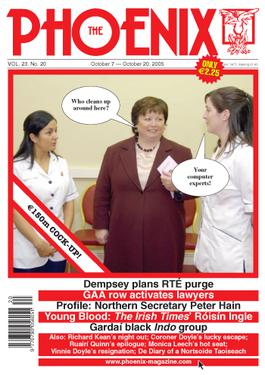
Phoenix
In his article on Phoenix Magazine Joe Breen cites a warning from Tony Harcup’s Journalism: Principle and Practice (London, 2009)] to the effect that investigative journalism, while achieving notable results might be seen as ‘perpetuating a myth that society is divided into a large number of fundamentally good people and a smaller number of fundamentally bad people’.
Harcup asks where the investigative journalism is into structural forces in society answering: ‘Largely notable for its absence. Instead, particularly on television, we tend to have personalised stories of goodies, baddies and heroic reporters’.
Nonetheless, the achievements of The Phoenix under the control of John Mulcahy and with Paddy Prendevilll as editor (a bulldog quality, untainted by ideology is also attributed to deputy editor Paul Farrell) in this vital sphere are arguably unsurpassed in the history Irish journalism.
Fittingly, an Irish Times obituary describes John Mulcahy as ‘one of the most significant journalists and publishers of the last half century in this country’. Phoenix’s major scoops have included: Charles Haughey receiving £1 million from Ben Dunne; the pension of £27.6 million paid to Michael Fingleton; Father Michael Cleary fathering a child with his housekeeper; and Anglo-Irish bank being technically bankrupt
In October 1991, Dick Spring quoted a Phoenix article at length in the Dáil. It had been pulled from the magazine when Smurfit Web Press refused to print it.
The magazine’s investigations are still accompanied by a Private Eye-infused humour, where Breen argues ‘laddish sexual innuendos were a staple’: as with the cartoon: ‘How’s the queen?’ Queen Elizabeth: ‘Edward’s fine, thank you’. The magazine has also displayed an unusual sympathy – in an Irish journalistic context at least – for the Republican cause in Northern Ireland.
Despite its achievements, Breen warns that that ‘it is notable that with the rise of social media, where people play fast and loose with facts, rumours and innuendo, The Phoenix has lost some of its traction.’
The Irish Housewife
The origins of the unradical-sounding The Irish Housewife magazine can be traced to a public ‘Memorandum on the Food and Fuel Emergency’ authored by Hilda Tweedy, Andreé Sheehy Skeffington; Marguerite Skelton and Nancy Simmons in 1941. According to Sonja Tiernan they ‘drew up an economic plan urging the government to ration all essential foodstuff, control prices and supress black-market sales.’
In response it was denigrated by journalists as ‘a housewives’ petition’. The authors appear to have inverted these prejudices by using ‘housewife’ in the title of the Association they founded, which went on to publish the magazine.
It is instructive that after Hilda Tweedy ‘applied for a teaching job in a Protestant girls’ school, she was told that as a married woman she was unsuitable; the headmistress said it would not be nice for girls if their teacher became pregnant.’
Importantly, according to Tiernan the Irish Housewives Association ‘had made a rather astute business deal with an advertising agency: The agency printed and distributed the magazine and in return they kept all of the advertising income.’ As articles were contributed for free it was kept at an affordable price.
Among its contributions, Katherine Watson recorded her experiences of visiting female prisoners in Mountjoy, while George Yeats (the daughter of W.B.) published an article entitled ‘Can Your Child Draw’ in which she warned: ‘don’t be too cautious! Beware of all that restricts a child’s boldness of hand and of imagination. More is at stake than his future as an artist.’
The advertising market began to slow down in the 1960s and by 1966 it was no longer viable for the agency to print the magazine. Nonetheless, it had provided an important outlet, and Tweedy later mused: ‘Who would have thought in 1942 that women would move from the kitchen to Áras an Uachtaráin.’
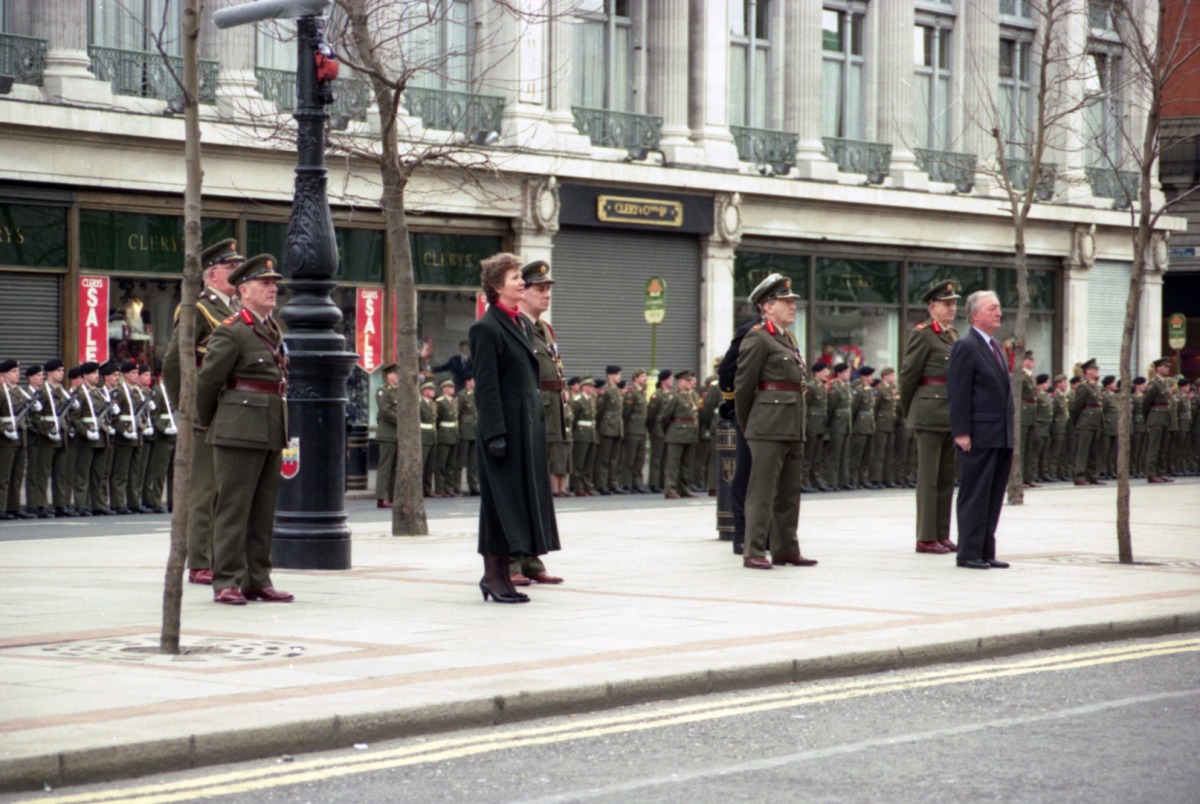
75th Anniversary of the Easter Rising, O’Connell Street, President Mary Robinson. Source: Dublin City Library Archive.
Status
Signs of the rise of future President Mary Robinson’s generation of successful and ambitious women can be identified in Status Magazine, a short-lived feminist news magazine from 1981.
Its origins lie in in the gathering of about 1,000 women and several men at a conference in Liberty Hall, which led to the founding of the magazine with Marian Finucane as editor. She was already a well-known Irish media personality. 31,500 copies of the first issue of Status were printed and these sold out quickly; yet curiously ten months later Status closed down.
The decision to launch a magazine squarely focused on women’s rights had come from the proprietor of Magill Magazine Vincent Browne’ who said: ‘News coverage and investigative journalism from a woman’s perspective is what we are aiming for.’
Cutting-edge reportage included Nell McCafferty writing from inside one of the mother and baby homes where single, pregnant women effectively went into hiding until their babies were born.
One regular feature that scared advertisers was a page headed ‘No Comment’, which reproduced snippets of sexist nonsense sent in by readers including advertisements and articles from national newspaper. This included one from the Irish Times, which observed that ‘sitting TDs, Mr Eddie Collins and Mr Austin Deasy, are regarded as “Garret men”, though not fanatically so: the young and pretty Mrs Bulbulia is taken for a dedicated “Garret woman”’.
Without adequate advertising revenue it was, however, doomed. Vincent Browne felt from the start the magazine was ‘gratuitously offensive to advertisers … There was too much sniping which antagonises people to no purpose.’ He noted that ‘marketing managers are male dominated and – dare I say it – some of them maybe, a little frightened’. Status was, he felt, a ‘bit too aggressively women’s lib’.
According to Tiernan: ‘The usual rules did not apply: Those controlling these decisions did not want to see their advertisements in Status no matter how many educated women were buying the magazine.’ Eventually, even those stalwarts of magazine advertising – cigarette companies – abandoned ship.
A Future for Hard Copy Journalism?
A final word goes to John S. Doyle the former editor of In Dublin, which was inspired by Pariscope, the New Yorker and London’s Time Out. It remained largely removed from the cut and thrust of national politics, apart from assessing the planning decisions of Dublin Corporation, and then providing an outlet for the campaign against the development of Wood Quay.
Intriguingly, Doyle revealed that
none of the people who started In Dublin, or who came to in the first few years, considered themselves to be journalists, or had thought of that as a career. They were people who, in their different ways, wanted to write, and one of the strengths of the magazine was that it attracted so many of them.
It may be that through some such formula – involving those with a desire and even need to write – we may revive dissenting journalism.
The challenge may be to find a broad-based platform that is not dependent on an increasingly commercialised and censorious social media for citizen journalists to publish. In this respect we mourn the demise of www.broadsheet.ie, which showed an usual willingness to court controversy, even if this occasionally placed them in the company of characters who apparently set out to cause offense.
A future for dissenting hard copy journalism that is not funded by an emanation of the state or philanthropy is difficult to identify, but it may be – just as music connoisseurs are now purchasing vinyl which was once considered obsolete – that readers will revert to a tangible format as the promblems with the digital medium become increasingly apparent.
Help keep this show on the road! We depend on readers’ support. You can contribute on an ongoing basis via Patreon or through a one-off contribution via Buy Me a Coffee. Any small amount is hugely appreciated.

